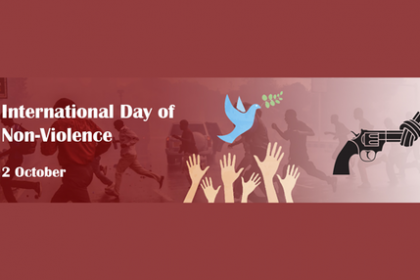
Every 2nd of October is dedicated as International Day of Non-Violence and World Smile Day. International days are occasions to educate the public on issues of concern, to mobilize political will and resources to address global problems, and to celebrate and reinforce achievements of humanity. The existence of international days predates the establishment of the United Nations, but the UN has embraced them as a powerful advocacy tool. The international Day of Non-Violence is observed on 2nd of October, the birthday of Mahatma Gandi, leader of the Indian Independence movement and pioneer of the philosophy and strategy of non-violence. The 2020 theme for the International Day of Peace is ‘’Shaping Peace Together’’. Celebrate the day by spreading compassion, kindness and hope in the face of the pandemic. Stand together with the UN against attempts to use the virus to promote discrimination or hatred. The purpose of this Article is to create Awareness about Violence, Different forms of Violence, prevention of Violence and how to create peace through Non-violence.
- WHO Defines Violence as the use of physical force or power, threatened or actual, against oneself, another person, or against a group or community, that either results in or has a high likelihood of resulting in Injury, death, psychological harm, mal development or deprivation.
- Nonviolent action is a technique by which people who reject passivity and submission and who see struggle as essential can wage conflict without violence.
- The principle of non-violence- also known as non-violent resistance- rejects the use of physical violence in order to achieve social or political change.
- We may never be strong enough to be entirely nonviolent in thought, word and deed. But we must keep nonviolence as our goal and make strong progress towards it.
- There are three main categories of non-violence action:
- Protest and persuasion, including marches and vigils;
- Non-cooperation; and
- Non-violent intervention such as blockades and occupations.
- In order to create a peaceful world, we must learn to practice nonviolence with one another in our day-to-day interactions by embracing the following:
- Harmony: choosing not to engage in any form of gossip today contributes to harmony.
- Friendliness
- Respect
- Generosity
- Listening
- Forgiveness
- Amends
- Praising
How to Achieve Peace through Nonviolence:
Become a champion of love and harmony by committing yourself to grow peace through nonviolence and build a better world by embracing the following:
- Promote diplomacy and meditation as means for resolving conflicts between the oppressed and oppressors. Practice your own diplomatic skills to convince others of your position.
- Advocate social justice, fair economic systems, democratic principles, understanding, respect, and tolerance between peoples.
- Oppose cultural violence and media violence through participation in boycotts, and local. State and national campaigns.
- Resist injustice through nonviolent demonstrations.
- Demonstrate peaceful acts of kindness daily.
- Foster peace education to promote the values, attitudes, and behaviors of nonviolence, conflict resolution, dialogue, and consensus building.
- Begin the process to achieve peace through nonviolence by first developing inner peace using meditation, prayer, and mindfulness.
In conclusion always remember that little or no progress can be achieved in an atmosphere of chaos, contribute your quota to the social and economic growth of the society you belong to by embracing nonviolent approach to achieve social or political change and rejects the use of physical violence.

